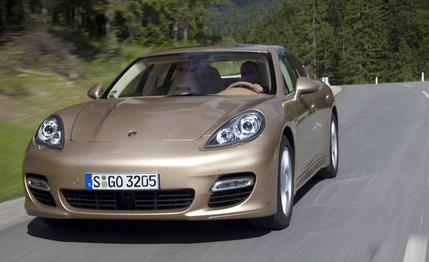
 First Drive Review
First Drive Review
The Panamera, Porsche’s fourth model line after the 911, Boxster/Cayman, and Cayenne, has arrived after years of rumor, innuendo, announcements, and buzz. A four-door fastback sedan positioned at the top of the lineup, the Panamera was officially unveiled at the Shanghai auto show in April, and Porsche chose to host the first official drive at the picturesque Schloß Elmau near Garmisch-Partenkirchen, under the shadow of the Zugspitze, Germany’s highest mountain. The ritzy castle hotel is separated from the Munich airport by two hours of twisty country roads and several stretches of unlimited autobahn, and we explored it all from behind the wheels of the entry-level, rear-wheel-drive, 400-hp Panamera S and the 500-hp, all-wheel-drive Turbo. (There’s also an all-wheel-drive Panamera 4S.)
Looks Less Controversial in the Flesh, Turbo Is Wicked Quick
The shape of the Panamera has been controversial, but we think it looks better on the road than in photos. Porsche’s designers have done their best to mask the Panamera’s size, but at 195.7 inches long and 55.8 inches tall, there is no way to hide that this is a large car. Outside, the S and 4S models are differentiated from the Turbo mostly by their front bumper and specific headlights, but those so inclined can spot a few minor differences, too.
With its 400-hp engine, the Panamera S boasts impressive performance claims: 0 to 60 mph is reached in 4.8 seconds, and 0 to 100 takes 11.5. Top speed is 175 mph. Sadly, it doesn’t feel that quick. There is no masking the Panamera’s weight; the Panamera S weighs more than 3900 pounds, and all-wheel drive adds a couple hundred more pounds. The Panamera’s heft means that you have to keep the pedal firmly to the floor and keep the seven-speed dual-clutch transmission busy to put a comfortable distance between you and plebs piloting shockingly quick turbo-diesels on the autobahn.
Unless, of course, you are driving the Turbo. The Turbo tips the scales at 4300-plus pounds, but the acceleration is almost surreal. According to Porsche, 0 to 60 mph takes 4.0 seconds, the sprint to 100 mph takes just 9.0 seconds, and top speed is a lofty 188 mph. Running full tilt in this car is an exquisite experience that would seem to justify every penny of the Turbo’s $132,600 asking price.
The differing experiences between the S and Turbo seem a bit strange, considering that the 100-hp gap between the two doesn’t sound like much. But the addition of two turbochargers increases the available torque from 369 lb-ft in the Panamera S and 4S to a maximum of 516 lb-ft in the Turbo—or 568 lb-ft if you order the optional Sport Chrono package. The naturally aspirated Panamera S is smooth and builds up speed in a linear way; the Turbo moves with a nonchalant effortlessness that is almost unparalleled. It takes a second for its turbos to spool up, but if you dare to stay on the gas, you’re basically catapulted forward into another dimension.
PDK Is the Only Way
Panameras that come to the U.S. will utilize the ZF-supplied, seven-speed PDK (Porsche Doppel-Kupplungsgetriebe) dual-clutch transmission. The seventh gear is so tall you cruise at 2800 rpm at 125 mph in the Turbo. First gear, on the other hand, is extremely short, and the shift from first to the preselected second occurs virtually unnoticed. If you hit the “sport plus” button that comes with the Sport Chrono package, the transmission will blip the throttle during downshifts. Nice.
All Panameras emit a pleasant and distant growl. There is an optional sport exhaust with flaps that can be activated at the push of a button. We still wish it were louder, but Porsche insists Panamera buyers have matured beyond our juvenile state of mind.
A standard stop/start system will turn off the engine every time you stop, with the engine then reignited as soon as you touch the gas. This device will up fuel economy in the city, but it takes some getting used to. In Europe, the Panamera was governmentally certified with the system in operation, and therefore, you need to turn it off with a button if you don’t care for it. In the U.S., however, Porsche was unsure about customer reaction, so therefore, the process is reversed. The stop/start system is off every time you start a journey, and you need to push a button to engage it.